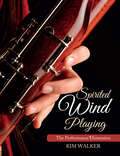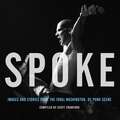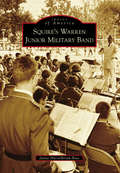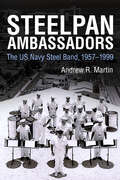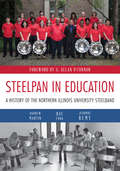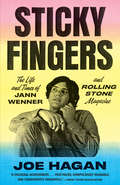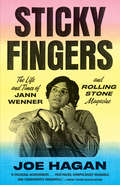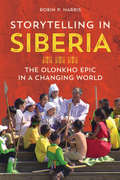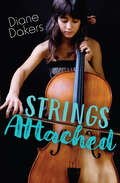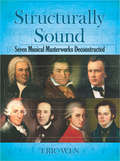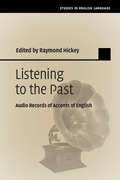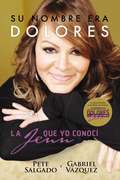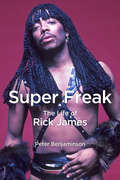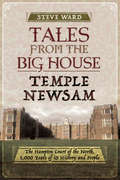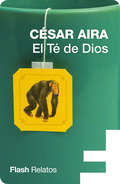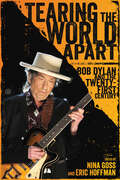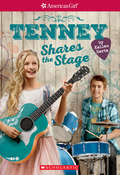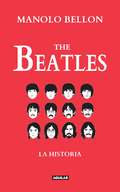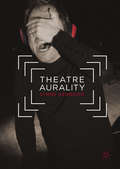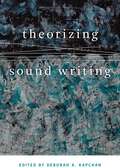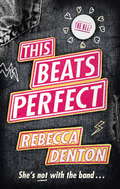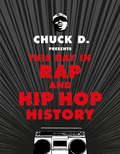- Table View
- List View
Spirited Wind Playing: The Performance Dimension
by Kim Walker Peter J. SchoenbachPeppered with tips, helpful hints, and personal anecdotes to illustrate real-life application, this performance guide is essential for any wind player interested in taking his or her virtuosity to the next level. Internationally renowned bassoonist Kim Walker has compiled into one book the teachings and exercises that have made her known as an expert on bassoon performance, practice, and instruction. From basics like posture, breathing techniques, and articulation to a survey of the performance practices of key woodwind and brass masters, Walker includes an analysis of each technique along with images and exercises that present the mechanics of each method.
Spoke: Images and Stories from the 1980s Washington, DC Punk Scene
by Scott Crawford"The pictures, which include some posed portraits but are mostly concert shots, are the chief attraction. They freeze moments of adolescent release, vein-bulging intensity and sweaty communion that fuses performer and audience...Vivid and evocative."--Washington Post"Scott Crawford, the man behind the acclaimed documentary Salad Days, has given us another taste of the best-kept secret of 80s in his new book Spoke: Washington DC’s hardcore punk scene."--Dazed"With music by Minor Threat, Void, Rites of Spring, Government Issue, and many others propelling the story of hardscrabble, Reagan-era D.C. as the hotbed for a new artistic outlet in Salad Days, Crawford saw the book as a way to scoop up important narrative from the cutting-room floor and find a new home for it."--Fast Company"Pockmarked with burned-out buildings and boarded-over storefronts, Northwest DC was once home to a vibrant and sometimes violent punk movement beginning in the early 1980s. For geeky 12-year-old Scott Crawford, that changed everything: He chucked comic books for punk rock and self-published a music zine from his mother’s kitchen table in Silver Spring. This month, Crawford releases a book about those days, Spoke--a companion to his 2014 documentary, Salad Days--featuring stories from local players such as Dave Grohl, Henry Rollins, and Ian MacKaye."--Washingtonian Magazine"Spoke...adroitly uses both photographs and oral histories to capture the importance of what can best be described as a cultural revolution within the nation’s capital."--Shepherd Express"This coffee table version of the documentary [Salad Days] follows the D.C. scene’s often politically-charged brand of punk rock, from Bad Brains to Jawbox, and of course the legendary Fugazi. And there’s even the near-forgotten SOA, whose frontman Henry Rollins took his D.C. energy to L.A. where he stepped in as the singer for Black Flag."--Yellow Scene Magazine"A must-have for any rock historian or pop-culture buff...The perfect punk coffee table book."--Shockwave Magazine"Highly recommended...A must read for punk fans."--Chorus.fm/HiFiNoise"A worthy addition to the growing amount of literature on the American hardcore/punk scene, Spoke will look great on any aging punks’ coffee table as a document to a vital, electric time."--Ink19.com"A forthright testament to a kaleidoscopic community. This is a rounded collection, with surprises on every page...It’s collection that rocks."--Shelf Awareness for ReadersThe Washington, DC punk music scene of the 1980s gave birth to influential bands like Bad Brains, Minor Threat, and Fugazi. Here that era is portrayed in its purest form: an oral history by the creators themselves, including nearly two hundred photographs capturing the power and spirit of this politically progressive corner of American underground music. This stunning and intimate collection features rare images from Jim Saah, Cynthia Connolly, Bert Queiroz, and many others who documented this vibrant community. Compiled by Scott Crawford-whose critically acclaimed film Salad Days provided an unprecedented exploration into the 1980s DC punk scene-Spoke delves deeper into one of the most dynamic movements in US music history.Featuring: BAD BRAINS, THE TEEN IDLES, BLACK MARKET BABY, SOA, MINOR THREAT, GOVERNMENT ISSUE, VOID, IRON CROSS, THE FAITH, SCREAM, MARGINAL MAN, GRAY MATTER, BEEFEATER, KING FACE, RITES OF SPRING, DAG NASTY, EMBRACE, SOULSIDE, FIRE PARTY, SHUDDER TO THINK, IGNITION, FUGAZI, SWIZ, THE NATION OF ULYSSES, and JAWBOX.
Squire's Warren Junior Military Band (Images of America)
by Janne Hurrelbrink-BiasSquire�s Warren Junior Military Band had an emotional appeal that endeared it to audiences of all ages. Considered one of northeastern Ohio�s richest artistic assets, the band�s members, who hailed from the entire region, were filled with pride, tradition, patriotism, and a sense of discipline. The original VFW Boys Band was formed in 1927, with Donald W. �Squire� Hurrelbrink becoming director in 1930. In 1957, the name changed to the Warren Junior Military Band. Travels took the band from the East Coast to the West Coast, from Canada to the Gulf of Mexico, and to audiences abroad, amassing an impressive record of Midwest, Canadian, European, American Legion, and VFW National Championships. Throughout the years, the band performed at numerous prestigious events and for an impressive number of dignitaries, as well as a phenomenal number of local, civic, and patriotic festivities. Members were privileged to have Squire�s leadership for 66 years. Alumni continued to lead, direct, and pass on the values they learned under Squire�s guidance. Finally, in 2010, the band ended its long legacy.
Steelpan Ambassadors: The US Navy Steel Band, 1957–1999 (Caribbean Studies Series)
by Andrew R. Martin“Maybe you won't like steel band. It's possible. But it's been said that the Pied Piper had a steel band helping him on his famous visit to Hamelin.” When the US Navy distributed this press release, anxieties and tensions of the impending Cold War felt palpable. As President Eisenhower cast his gaze towards Russia, the American people cast their ears to the Atlantic South, infatuated with the international currents of Caribbean music. Today, steelbands have become a global phenomenon; yet, in 1957 the exotic sound and the unique image of the US Navy Steel Band was one-of-a-kind. Could calypso doom rock 'n' roll? Band founder Admiral Daniel V. Gallery thought so and envisioned his steelband knocking “rock 'n' roll and Elvis Presley into the ash can.” From 1957 until their disbandment in 1999, the US Navy Steel Band performed over 20,000 concerts worldwide. In 1973, the band officially moved headquarters from Puerto Rico to New Orleans and found the city and annual Mardi Gras tradition an apt musical and cultural fit. The band brought a significant piece of Caribbean artistic capital—calypso and steelband music—to the American mainstream. Its impact on the growth and development of steelpan music in America is enormous. Steelpan Ambassadors uncovers the lost history of the US Navy Steel Band and provides an in-depth study of its role in the development of the US military's public relations, its promotion of goodwill, its recruitment efforts after the Korean and Vietnam Wars, its musical and technological innovations, and its percussive propulsion of the American fascination with Latin and Caribbean music over the past century.
Steelpan in Education: A History of the Northern Illinois University Steelband
by Andrew Martin Ray Funk Jeannine RemyFounded by Al O'Connor in 1973, the steelband program at Northern Illinois University was the first of its kind in the United States. Thanks to the talent and dedication of O'Connor, Cliff Alexis, Liam Teague, Yuko Asada, and a plethora of NIU students and staff members, the program has flourished into one of the most important in the world. Having welcomed a variety of distinguished guest artists and traveled to perform in locales around the US and in Taiwan, Trinidad, and South Korea, the NIU Steelband has achieved international acclaim as a successful and unique university world music program. This fascinating history of the NIU Steelband traces the evolution of the program and engages with broader issues relating to the development of steelband and world music ensembles in the American university system. In addition to investigating its past, Steelpan in Education looks to the future of the NIU Steelband, exploring how it attracts and trains new generations of elite musicians who continue to push the boundaries of the steelpan. This study will appeal to musicians, music educators, ethnomusicologists, and fans of the NIU Steelband.
Sticky Fingers: The Life and Times of Jann Wenner and Rolling Stone Magazine
by Joe HaganThe first and only biography of Jann Wenner, the iconic founder of Rolling Stone magazine, and a romp through the hothouses of rock and roll, politics, media, and Hollywood, from the Summer of Love to the Internet age.Lennon. Dylan. Jagger. Belushi. Leibovitz. The story of Jann Wenner, Rolling Stone's founder, editor, and publisher, is an insider's trip through the backstages of storied concert venues, rock-star hotel rooms, and the political ups and downs of the latter half of the Twentieth Century, right up through the digital age: connecting the counterculture of Haight Ashbury to the "straight world." Supplemented by a cache of extraordinary documents and letters from Wenner's personal archives, Sticky Fingers is the story of a mercurial, wide-eyed rock and roll fan of ambiguous sexuality but unambiguous ambition who reinvents youth culture, marketing the libertine world of the late sixties counterculture in a stylish, glossy package that would stand for decades as a testament to the cultural power of American youth. Joe Hagan captures in stunning detail the extraordinary lives constellated around a magazine that began as a scrappy rebellion and became a locus of power, influence, and access--using hundreds of hours of reporting and exclusive interviews. The result is a fascinating and complex portrait of Jann Wenner that is also a biography of popular culture, celebrity, music, and politics in America over the last fifty years.
Sticky Fingers: The Life and Times of Jann Wenner and Rolling Stone Magazine
by Joe HaganThe first and only biography of Jann Wenner, the iconic founder of Rolling Stone magazine, and a romp through the hothouses of rock and roll, politics, media, and Hollywood, from the Summer of Love to the Internet age.Lennon. Dylan. Jagger. Belushi. Leibovitz. The story of Jann Wenner, Rolling Stone's founder, editor, and publisher, is an insider's trip through the backstages of storied concert venues, rock-star hotel rooms, and the political ups and downs of the latter half of the Twentieth Century, right up through the digital age: connecting the counterculture of Haight Ashbury to the "straight world." Supplemented by a cache of extraordinary documents and letters from Wenner's personal archives, Sticky Fingers is the story of a mercurial, wide-eyed rock and roll fan of ambiguous sexuality but unambiguous ambition who reinvents youth culture, marketing the libertine world of the late sixties counterculture in a stylish, glossy package that would stand for decades as a testament to the cultural power of American youth. Joe Hagan captures in stunning detail the extraordinary lives constellated around a magazine that began as a scrappy rebellion and became a locus of power, influence, and access--using hundreds of hours of reporting and exclusive interviews. The result is a fascinating and complex portrait of Jann Wenner that is also a biography of popular culture, celebrity, music, and politics in America over the last fifty years.
Sticky Fingers: The Life and Times of Jann Wenner and Rolling Stone Magazine
by Joe HaganA delicious romp through the heyday of rock and roll and a revealing portrait of the man at the helm of the iconic magazine that made it all possible, with candid look backs at the era from Mick Jagger, Keith Richards, Elton John, Bono, Bruce Springsteen, Paul McCartney, and others. The story of Jann Wenner, Rolling Stone's founder, editor, and publisher, and the pioneering era he helped curate, is told here for the first time in glittering, glorious detail. Joe Hagan provides readers with a backstage pass to storied concert venues and rock-star hotel rooms; he tells never before heard stories about the lives of rock stars and their handlers; he details the daring journalism (Tom Wolfe, Hunter S. Thompson, P.J. O’Rourke) and internecine office politics that accompanied the start-up; he animates the drug and sexual appetites of the era; and he reports on the politics of the last fifty years that were often chronicled in the pages of Rolling Stone magazine. Supplemented by a cache of extraordinary documents and letters from Wenner's personal archives, Sticky Fingers depicts an ambitious, mercurial, wide-eyed rock and roll fan of who exalts in youth and beauty and learns how to package it, marketing late sixties counterculture as a testament to the power of American youth. The result is a fascinating and complex portrait of man and era, and an irresistible biography of popular culture, celebrity, music, and politics in America.
Storytelling in Siberia: The Olonkho Epic in a Changing World
by Robin P HarrisOlonkho , the epic narrative and song tradition of Siberia 's Sakha people, declined to the brink of extinction during the Soviet era. In 2005, UNESCO 's Masterpiece Proclamation sparked a resurgence of interest in olonkho by recognizing its important role in humanity 's oral and intangible heritage. Drawing on her ten years living in the Russian North, Robin P. Harris documents how the Sakha have used the Masterpiece program to revive olonkho and strengthen their cultural identity. Harris 's personal relationships with and primary research among Sakha people provide vivid insights into understanding olonkho and the attenuation, revitalization, transformation, and sustainability of the Sakha 's cultural reemergence. Interdisciplinary in scope, Storytelling in Siberia considers the nature of folklore alongside ethnomusicology, anthropology, comparative literature, and cultural studies to shed light on how marginalized peoples are revitalizing their own intangible cultural heritage.
Strings Attached (Orca Limelights)
by Diane DakersBrielle and Tawni have played cello side by side in orchestras since they were nine years old. Brielle has always played second chair to Tawni’s first, and she's been happy with that arrangement. When Tawni is injured, Brielle suddenly finds herself principal cellist. Not only does that mean she'll be thrust into the spotlight, but it also means she is now leader of the cello section. Brielle is terrified. Is she good enough? Will the other musicians accept her? What if she screws up? Despite her fears, Brielle rises to the occasion. Her cello skills, and her leadership skills, improve as she grows into her new role. But just as Brielle is beginning to feel confident, Tawni returns. And she wants her job back. If Brielle steps down now, she'll lose her place in the spotlight. If she doesn't, her friendship could be in jeopardy.
Structurally Sound: Seven Musical Masterworks Deconstructed (Dover Books on Music)
by Eric WenMusic theorist Eric Wen presents in-depth analyses of seven masterworks from the common-practice period of Western art music:Bach: Air from Orchestral Suite No. 3 in D, BWV 1068 Mendelssohn: Andante con moto tranquillo from Piano Trio No. 1 in D minor, Op. 49 Schubert: Nacht und Traüme, D. 827 Haydn: Adagio — Vivace assai from Symphony No. 94 in G, Hob. I:94 Mozart: Molto Allegro from Symphony No. 40 in G minor, K. 550 Beethoven: Marcia funebre: Adagio assai from Symphony No. 3 in E-flat, Op. 55 Brahms: Un poco presto e con sentimento from Violin Sonata No. 3 in D minor, Op. 108Wen employs the analytic approach developed by Heinrich Schenker, a method that uses musical notation to clarify and illuminate a work's structural hierarchies. Copiously illustrated with analytic musical examples that elucidate the tonal organization of each of the seven works, this study also explores aspects of form, rhythmic organization, and programmatic meaning. This volume will be of particular interest to musicologists and professional musicians, and it will also appeal to listeners keen to probe the rich complexities of these masterpieces.
Studies in English Language: Listening to the Past
by Raymond HickeyAudio recordings of English are available from the first half of the twentieth century and thus complement the written data sources for the recent history of the language. This book is the first to bring together a team of globally recognised scholars to document and analyse these early recordings in a single volume. Looking at examples of regional varieties of English from England, Scotland, Ireland, the USA, Canada and other anglophone countries, the volume explores both standard and vernacular varieties, and demonstrates how accents of English have changed between the late nineteenth century and the present day. The socio-phonetic examinations of the recordings will be of interest to scholars of historical linguistics, the history of the English language, language variation and change, phonetics, and phonology.
Studies in Historical Improvisation: From Cantare super Librum to Partimenti
by Massimiliano GuidoIn recent years, scholars and musicians have become increasingly interested in the revival of musical improvisation as it was known in the Renaissance and Baroque periods. This historically informed practice is now supplanting the late Romantic view of improvised music as a rhapsodic endeavour—a musical blossoming out of the capricious genius of the player—that dominated throughout the twentieth century. In the Renaissance and Baroque eras, composing in the mind (alla mente) had an important didactic function. For several categories of musicians, the teaching of counterpoint happened almost entirely through practice on their own instruments. This volume offers the first systematic exploration of the close relationship among improvisation, music theory, and practical musicianship from late Renaissance into the Baroque era. It is not a historical survey per se, but rather aims to re-establish the importance of such a combination as a pedagogical tool for a better understanding of the musical idioms of these periods. The authors are concerned with the transferral of historical practices to the modern classroom, discussing new ways of revitalising the study and appreciation of early music. The relevance and utility of such an improvisation-based approach also changes our understanding of the balance between theoretical and practical sources in the primary literature, as well as the concept of music theory itself. Alongside a word-centred theoretical tradition, in which rules are described in verbiage and enriched by musical examples, we are rediscovering the importance of a music-centred tradition, especially in Spain and Italy, where the music stands alone and the learner must distil the rules by learning and playing the music. Throughout its various sections, the volume explores the path of improvisation from theory to practice and back again.
Su nombre era Dolores: La Jenn que yo conocí
by Gabriel Vázquez Aguayo Pete SalgadoLa historia jamás contada del ícono musical, Jenni Rivera, relatada a través de la perspectiva de dos exmánagers, Pete Salgado y Gabriel Vazquez, y es la base para la serie de televisión que se transmitirá en Univision. Este libro nos lleva al ojo del huracán y ofrece una perspectiva a las estrategias y momentos que llevaron a Jenni a los titulares nacionales. Pete Salgado fue un apoyo fundamental en la carrera de Jenni, y lo considerado como su quinto hermano. Salgado trabajó con ella casi una década y ayudó a negociar muchos de sus contratos. Jenni compartió cosas con él, que no compartió con nadie más, y llegó a conocerla en formas que nadie más lo hizo. Los meses previos a la muerte de Jenni estuvieron llenos de traiciones y desilusiones de las personas que ella más amaba y en quienes confiaba. Salgado aborda el tema y lleva a los lectores a descifrar algunos de los tuits publicados por Jenni, así como también esclarece asuntos tales como: ¿Chiquis tuvo un romance con el esposo de Jenni, Esteban? ¿Quién era realmente El Pelón, acerca del que Jenni tuiteaba y qué significaba para ella? ¿Estuvo Jenni involucrada con el cartel de la droga? ¿El narco llamado El Barbie la maltrataba? ¿Iba Jenni a comprar un avión? ¿Fue la muerte de Jenni realmente un accidente? Este libro describe todo lo que pasó hasta ese momento final y, por primera vez, ofrece detalles sobre la belleza, el amor, la complejidad y el dolor de la relación de Jenni con Chiquis, la cual fue muy diferente y mucho más allá de la relación tradicional de madre e hija. Salgado comparte quién era Dolores realmente, la que sus seguidores no conocían y nunca vieron en el escenario... Salgado y Vazquez ofrecen una mejor perspectiva de la vida de «la diva de la banda» por las dos personas involucradas más profundamente en su carrera y que la conocían como nadie más.
Super Freak: The Life of Rick James
by Peter BenjaminsonRick James played with Neil Young, self-produced his first album (later picked up by Motown), crossed rock and funk to come up with one of the best-selling albums of the 1980s, became one of the biggest pop stars of the era, turned a young white woman named Teena Marie into an R&B superstar, displayed an outrageously sex- and drug-filled lifestyle, was tried and found guilty of assaulting and imprisoning a young woman, went on to record new music that was compared to the Beatles' White Album, and ended his life as a punch line for Dave Chappelle. James attempted to tell his own story—in two different books—but left out many incidents that reflected badly on his character. Now, based on court records, newspaper archives, and extensive interviews with dozens of family members, band members, friends, and lovers, here is the definitive biography of Motown's most controversial superstar.
Tales from the Big House: The Hampton Court of the North, 1,000 Years of Its History and People
by Steve WardSituated only 4 miles southeast of the bustling cosmopolitan city of Leeds lies a jewel in the crown of British stately homes. Set in 1,200 acres of rolling parkland and woods is Temple Newsam House, once described as the Hampton Court of the North.The estate has survived almost 900 years of history. Although first mentioned in the Domesday Book, it was the Knights Templar who gave the name to the land. The house that now stands on the site was begun in 1518 and has witnessed many events: the execution for treason of one of its owners; the birth of Lord Darnley, unlucky husband of Mary Queen of Scots; the Civil War rivalry of a family; the home of a flirtatious mistress of the Prince of Wales (later George IV); and the suffering of the First World War, when it was used as a convalescent home for wounded soldiers.The house and estate is now owned by the Leeds City Council and is open as a public park for all to enjoy. The house itself is part of Leeds Museums and Galleries and displays many different collections and exhibitions. On the estate is a working farm, known as Home Farm, which is the largest working rare breed center in the UK and is a popular attraction for many visitors.
El Té de Dios (Flash Relatos)
by César AiraHumor y parodia se dan la mano en este relato divino. El Té de Dios, el legendario Té con el que Dios festeja su cumpleaños y en el que solo acuden los monos, se ve irrumpido por la inesperada aparición de una intrusa, una partícula subatómica que revolucionará la fiesta. Reseña:«No se sabe si realmente lo es o si, de verdad, se hace. César Aira, el escritor argentino más prolífico (y quizás uno de los dos o tres autores más interesantes de los últimos años), a veces puede parecer un genio, y a veces también.»Diego Gándara, Qué leer
Tearing the World Apart: Bob Dylan and the Twenty-First Century (American Made Music Series)
by Nina Goss and Eric HoffmanContributions by Alberto Brodesco, James Cody, Andrea Cossu, Anne Margaret Daniel, Jesper Doolard, Nina Goss, Jonathan Hodgers, Jamie Lorentzen, Fahri Öz, Nick Smart, and Thad Williamson Bob Dylan is many things to many people. Folk prodigy. Rock poet. Quiet gentleman. Dionysian impresario. Cotton Mather. Stage hog. Each of these Dylan creations comes with its own accessories, including a costume, a hairstyle, a voice, a lyrical register, a metaphysics, an audience, and a library of commentary. Each Bob Dylan joins a collective cast that has made up his persona for over fifty years. No version of Dylan turns out uncomplicated, but the postmillennial manifestation seems peculiarly contrary—a tireless and enterprising antiquarian; a creator of singular texts and sounds through promiscuous poaching; an artist of innovation and uncanny renewal. This is a Dylan of persistent surrender from and engagement with a world he perceives as broken and enduring, addressing us from a past that is lost and yet forever present. Tearing the World Apart participates in the creation of the postmillennial Bob Dylan by exploring three central records of the twenty-first century—“Love and Theft” (2001), Modern Times (2006), and Tempest (2012)—along with the 2003 film Masked and Anonymous, which Dylan helped write and in which he appears as an actor and musical performer. The collection of essays does justice to this difficult Bob Dylan by examining his method and effects through a disparate set of viewpoints. Readers will find a variety of critical contexts and cultural perspectives as well as a range of experiences as members of Dylan's audience. The essays in Tearing the World Apart illuminate, as a prism might, their intransigent subject from enticing and intersecting angles.
Tenney Shares the Stage: Tenney Grant, Book 3) (Tenney Grant #3)
by Kellen HertzTenney & Logan are a harmonious match onstage, but behind the scenes, they are totally out of tune. In this third novel, Tenney has signed a recording contract and is ready to make the album of her dreams . . . she just wishes she didn't have to do it with moody Logan Everett! They're supposed to be songwriting partners, but Logan doesn't even seem to be trying. Just when it looks like they've found their harmony, Logan suddenly disappears, and Tenney wonders if he has bailed on their act. A couple of months ago, Tenney would have gladly taken the opportunity to go solo. But as she learns more of Logan's story, she begins to wonder: Do she and Logan need each other--and their music--now more than ever before?
The Beatles
by Manolo Bellon BenkendoerferLas mejores historias de The Beatles. El gran experto en The Beatles tiene nombre propio: Manolo Bellón. En el 2002 Bellón publicó este libro, que recoge una de las historias más completas sobre este cuarteto que se hayan escrito antes en cualquier idioma. Ahora, cuando se cumplen los 51 años del último concierto que dieron The Beatles (29 de agosto de 1966), Manolo vuelve sobre las líneas escritas y presenta una edición totalmente revisada, corregida y sobre todo aumentada: cada detalle, presentación, problema, canción o dato relevante de Lennon y sus amigos se recoge en este libro. Además, cuenta con una completísima discografía que va hasta el año 2016, pues la disquera dueña de los derechos musicales del grupo ha hecho un sin número de remasterizaciones, que son recogidas en detalle por Manolo Bellón, el gran beatlemano lationamericano.
Theatre Aurality
by Lynne KendrickThis book explores the critical field of theatre sound and the sonic phenomena of theatre. It draws together a wide range of related topics, including sound design and sonic sonographies, voice as a performance of sound, listening as auditory performance, and audience as resonance. It explores radical forms of sonic performance and our engagement in it, from the creation of sonic subjectivities to noise as a politics of sound. The introductory chapters trace the innate aurality of theatre and the history of sound effects and design, while also interrogating why the art of theatre sound was delayed and underrepresented in philosophy as well as theatre and performance theory. Subsequent chapters explore the emergence of aurally engaged theatre practice and focus on examples of contemporary sound in and as theatre, including theatre in the dark, headphone theatre and immersive theatre, amongst others, through theories of perception and philosophies of listening, vocality, sonority and noise.
Theorizing Sound Writing
by Deborah KapchanThe study of listening—aurality—and its relation to writing is the subject of this eclectic edited volume. Theorizing Sound Writing explores the relationship between sound, theory, language, and inscription. This volume contains an impressive lineup of scholars from anthropology, ethnomusicology, musicology, performance, and sound studies. The contributors write about sound in their ongoing work, while also making an intervention into the ethics of academic knowledge, one in which listening is the first step not only in translating sound into words but also in compassionate scholarship.
They Can't Kill Us Until They Kill Us: Essays
by Hanif Abdurraqib<p>In an age of confusion, fear, and loss, Hanif Willis-Abdurraqib's is a voice that matters. Whether he's attending a Bruce Springsteen concert the day after visiting Michael Brown's grave, or discussing public displays of affection at a Carly Rae Jepsen show, he writes with a poignancy and magnetism that resonates profoundly. <p>In the wake of the nightclub attacks in Paris, he recalls how he sought refuge as a teenager in music, at shows, and wonders whether the next generation of young Muslims will not be afforded that opportunity now. While discussing the everyday threat to the lives of black Americans, Willis-Abdurraqib recounts the first time he was ordered to the ground by police officers: for attempting to enter his own car. <p>In essays that have been published by the New York Times, MTV, and Pitchfork, among others―along with original, previously unreleased essays―Willis-Abdurraqib uses music and culture as a lens through which to view our world, so that we might better understand ourselves, and in so doing proves himself a bellwether for our times.</p>
This Beats Perfect (This Beats Perfect #1)
by Rebecca Denton'This Beats Perfect is a fabulous celebration of music, friendship, and following your dreams' Katherine Webber, author of Wing JonesAmelie Ayres has impeccable taste in music. Bowie. Bush. Bob. So when she finds herself backstage at The Keep's only UK gig she expects to hate it; after all they are the world's most tragic band. In fact she feels a grudging respect - not (obviously) for their music, but for the work that goes in to making them megastars. And when lead singer, 'Maxx', is not dressed up as a cross between Elvis and a My Little Pony, he is actually rather normal, talented and has creative struggles not too dissimilar to her own. But the next morning she wakes up and rolls over to discover a million new @'s on social media. Overnight, a photo of her at the gig has made her a subject of global speculation. Suddenly the world needs to know #Who'sThatGirl? - but for all the wrong reasons.All Amelie wants is to play her music. She's got the guitar, the songs, the soul and, in the safety of her bedroom, she's got the voice. But when it comes to getting up on stage, she struggles with self-doubt.Immaculate's a concept. Flawless is fake. But just sometimes music - and hearts - can rock a perfect beat.'A witty exploration into the world of celebrity' The Sun
This Day in Rap and Hip-Hop History
by Chuck DForeword by Shepard Fairey.As featured in Best stocking-filler books of 2017 - The GuardianIf you want to understand our culture. To learn knowledge itself. Truth about the art form of poetry in motion. The struggle of our community through rhyme and rhythm. This is the book that inspired me long before I found my place in hip-hop. The power of self-expression. Unapologetically. Taught by the teacher himself. Chuck D!!!Kendrick LamarThis book is required reading for those who claim to know hip-hop, love hip-hop, and want their information from a true Master and General of the hip-hop culture...Public Enemy #1, Chuck D!Ice-TChuck D wasn't put here to play any games. He created the greatest hip-hop album in my opinion to date, It Takes a Nation of Millions to Hold Us Back. But the very first minute he sonically appeared to us, I knew rap was changed forever. Power, awareness, strength, and militancy is his stance in a world obsessed with punishing poor people. I knew he would righteously and boldly die so that a little young boy he didn't even know from Queensbridge could live. He attacked wickedness head-on being the rappin' rhino terror that he is. He represented for all of us putting his life on the line and making the right music fighting for hip hop, the youth, truth, and justice. Chuck D made the lane for people like me to walk.NasReading this book is like reliving my life all over again. Chuck D is Dope!!!LL Cool JIn the more than 40 years since the days of DJ Kool Herc and "Rapper's Delight," hip-hop and rap have become a billion-pound worldwide cultural phenomenon that reaches well beyond music, into fashion, movies, art and politics. Yet there is no definitive history of the genre - until now.This massive compendium details the most iconic moments and influential songs in the genre's recorded history, from Kurtis Blow's "Christmas Rappin'" to The Miseducation of Lauryn Hill to Kendrick Lamar's verse on "Control." Also included are key events in hip-hop history, from Grandmaster Flash's first scratch through to Tupac's holographicappearance at Coachella.Throughout the book, Chuck offers an insider's perspective on the chart toppers, artists and key moments. Illustrating the pages are more than 150 portraits from mADurgency, an artist collective specialising in art and design for the hip-hop community.
